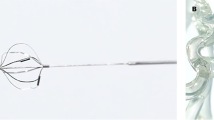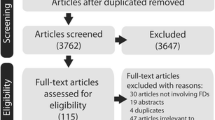Abstract
The treatment of large or wide-necked cerebral aneurysms is extremely difficult, and carries a high risk of rupture, even when surgical or endovascular methods are available. We are developing novel honeycomb microporous covered stents for treating such aneurysms. In this study, 3 experimental animal models were designed and evaluated quantitatively before preclinical study. The stents were prepared using specially designed balloon-expandable stents (diameter 3.5–5.0 mm, length 16–28 mm) by dip-coating to completely cover their struts with polyurethane film (thickness 20 µm) and microprocessing to form the honeycomb pattern after expansion. (1) In an internal carotid artery canine model (n = 4), all stents mounted on the delivery catheter passed smoothly through the tortuous vessel with minimal arterial damage. (2) In an the large, wide-necked, outer-sidewall aneurysm canine model, almost all parts of the aneurysms had embolized immediately after stenting (n = 4), and histological examination at 2 months revealed neointimal formation with complete endothelialization at all stented segments and entirely organized aneurysms. (3) In a perforating artery rabbit model, all lumbar arteries remained patent (n = 3), with minimal change in the vascular flow pattern for over 1 year, even after placement of a second, overlapping stent (n = 3). At 2 months after stenting, the luminal surface was covered with complete thin neointimal formation. Excellent embolization performance of the honeycomb microporous covered stents without disturbing branching flow was confirmed at the aneurysms in this proof-of-concept study.






Similar content being viewed by others
References
Fiorella D, Woo HH, Albuquerque FC, Nelson PK. Definitive reconstruction of circumferential fusiform intracranial aneurysms with the pipeline embolization device. Neurosurgery. 2008;62:1115–21.
Lylyk P, Miranda C, Ceratto R, Ferrario A, Scrivano E, Luna HR, Berez AL, Tran Q, Nelson PK, Fiorella D. Curative endovascular reconstruction of cerebral aneurysms with the pipeline embolization device: the Buenos Aires experience. Neurosurgery. 2009;64:632–42.
Saatci I, Yavuz K, Ozer C, Geyil S, Cekirge HS. Treatment of intracranial aneurysms using the Pipeline flow diverter embolization device: a single-center experience with long-term follow-up results. AJNR Am J Neuroradiol. 2012;33:1436–46.
Nihi S, Nakayama Y, Ishibashi-Ueda H, Okamoto Y, Yoshida M. Development of microporous self-expanding stent grafts for treating cerebral aneurysms: designing micropores to control intimal hyperplasia. J Artif Organs. 2011;14:348–56.
Nishi S, Nakayama Y, Ishibashi-Ueda H, Yoshida M, Yonetani H. Treatment of rabbit carotid aneurysms by hybrid stents (microporous thin polyurethane-covered stents): preservation of side-branches. Biomater Appl. 2014;28:1097–104.
Bonneville F, Sourour N, Biondi A. Intracranial aneurysms: an overview. Neuroimaging Clin N Am. 2006;16:371–82.
Li J, Lan ZG, Liu Y, He M, You C. Large and giant ventral paraclinoid carotid aneurysms; surgical techniques, complications and outcomes. Clin Neurol Neurosurg. 2012;114:907–13.
Ross IB, Weil A, Piotin M, Moret J. Endovascular treatment of distally located giant aneurysms. Neurosurgery. 2002;47:1147–52.
Standhardt H, Boecher-Schwarz H, Gruber A, Benesch T, Knosp E, Bavinzski G. Endovascular treatment of unruptured intracranial aneurysms with Guglielmi detachable coils: short- and long-term results of a single-centre series. Stroke. 2008;39:899–904.
Gruber A, Killer M, Bavinzski G, Richling B. Clinical and angiographic results of endosaccular coiling treatment of giant and very large intracranial aneurysms: a 7-year, single-center experience. Neurosurgery. 1999;45:793–800.
Zhu YQ, Li MH, Xie J, Tan HQ, Cheng YS, Wang JB. Treatment of carotid siphon aneurysms by use of the Willis stent graft: an angiographic and histopathological study. Eur Radiol. 2010;20:1974–84.
Tajikawa T, Nakagawa Y, Kurebayashi Y, Nishi S, Nakayama Y. Development of microporous covered stent for cerebral aneurysm treatment. Trans JSME Ser. 2013;79:2013–5.
Nishi S, Nakayama Y, Ishibashi-Ueda H, Masato Y. Occlusion of canine aneurysms using microporous self-expanding stent grafts: long-term follow-up. Clin Neurol Neurosurg. 2014;122:34–41.
Masuo O, Terada T, Walker G, Tsuura M, Matsumoto H, Tohya K, Kimura M, Nakai K, Itakura T. Study of the patency of small arterial branches after stent placement with an experimental in vivo medel. AJNR Am J Neuroradiol. 2002;23:706–10.
Acknowledgments
This work was performed as a Medical Device Innovation Circumstances Improvement (Medici) project, and was supported by grants from the Ministry of Health, Labor, and Welfare of Japan. Three experimental animal models were designed based on advices from Japan’s Pharmaceuticals and Medical Devices Agency (PMDA).
Author information
Authors and Affiliations
Corresponding author
Ethics declarations
Conflict of interest
None.
Rights and permissions
About this article
Cite this article
Nakayama, Y., Satow, T., Funayama, M. et al. Construction of 3 animal experimental models in the development of honeycomb microporous covered stents for the treatment of large wide-necked cerebral aneurysms. J Artif Organs 19, 179–187 (2016). https://doi.org/10.1007/s10047-015-0879-0
Received:
Accepted:
Published:
Issue Date:
DOI: https://doi.org/10.1007/s10047-015-0879-0




